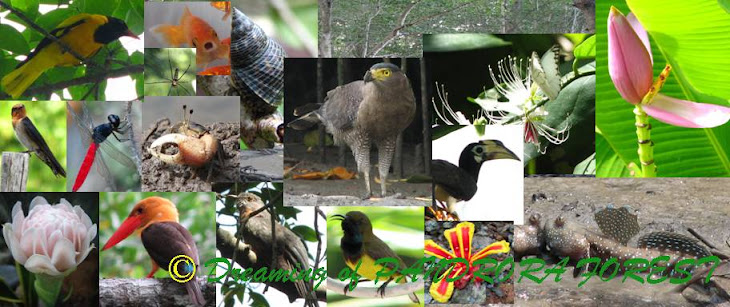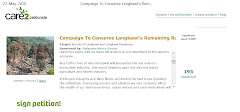M and I had nothing much to do on that day and decided to take a ferry down to Payar Island which is supposedly reputed to be the best coral reefs area in the West Peninsula Malaysia. Payar Island is the nearest getaway for cityfolks of Penang, Perak, Perlis and Kedah for snorkelling and diving.
Before we even got off the ferry, we were already put off by the operator's announcement on the timing for the sharks feeding. Instead of watching some sharks scavenging on the scrap food leftover by the tourists' lunch boxes, we decided to take a stroll.
We walked towards the other end of the boardwalk and we were shocked to see a few "alien aircrafts" have landed on the slope of the Payar Island hill.
Semi UFO or Half-golf ball looking chalet. Weird design when it is not even a golf resort.
Thru the "western and eastern wind", we came to know that the whole thing was supposed to be a resort built by by the former Kedah's head of government, Syed Razak bin Syed Zain Barakhbah. The resort was built and it was left abandoned before the operation started. The reasons could be due to strong opposition from other parties that were concerned about the environmental damage. Or possibly Syed Razak had a downfall.
So now that these existing structures are already in placed and what next? Well, since the state is under the new government, YB. Encik Mohammad Radzhi Bin Salleh, the Exco Tourism of Kedah state had approved the operation of 12-room resort. And the winner of the project taker is Raymond Foo of D'Coconut Resort. This information is taken from Langkawi's Marine Park Gets a Resort. You may also read from the comments that Raymond pledged to run the resort in a "green" way. How "green" can be achieved in this highly sensitive area? I'm afraid I'm a non-believer in a green resort. There would be some amount of impact and the only question is how much. What more can the impact do to a highly sensitive area like Payar Island.
Payar Island does not have vast flat areas. Behind the small beaches is the range of hill. That's why the stilted chalets were built on the slopes of the hill.
This is a high potential for sediment run-off during heavy rain and thus increasing sedimentation load on the corals. The increasing sedimentation load on the corals will lead to blocking off sunlight thus reducing the growth of corals.
Human waste will go down into the sewage tank below and eventually cause seepage into the underground. There is no sign of sewage or waste treatment area built. Looking at the geographical landscape of Payar Island, it is almost impossible to build one when there is a lack of flat areas. What if the tank is filled? Nutrients run-off from human activities will encourage algae growth and eventually competes with the corals for sunlight and living space. When corals die, it will be a domino affect, the marine fishes will eventually die.
Here are more hideous looking chalets:
We wonder if any recent an EIA was done for this project? Will our government care enough to do a thorough survey or health check on the corals before allowing the operation of this resort?
For further reports highlighted to the media: Letter to MalaysiaKini, EcoMalaysia.org
Sadly, the jewel of Langkawi is willing to be sacrificed for the sake of making quick monetary return instead of conserving what is left on our west coast and not realising that the rice bowl of the islanders will eventually be broken.
Eventhough it was supposedly a low season on that day, look at the number of people on that beach. I wonder what will be like on high season... eeewwwww...
Other references:
2. WWF's Lim lee ching "Lim, L.C., 1998. Carrying Capacity Assessment of Pulau Payar Marine Park, Malaysia - Bay of Bengal Programme.
... Read full post ...



































